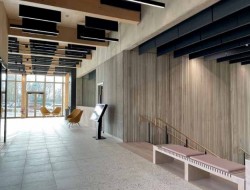The new £54million state-of-the-art, five-storey research building for the University of Warwick, used the award-winning HybriDfMA frame system to complement an adjacent timber structural frame.
Located on the Gibbet Hill campus,
the development brings together up
to 300 biomedical researchers from
across the School of Life Sciences
and Warwick Medical School to fight
human diseases.
The building used PCE’s system build frame solution/HybriDfMA approach. The hybrid frame is constructed from a mixture of precast concrete components including columns, beams, solid walls, hollowcore flooring, delta beams and stairs and landings, with a structural concrete topping creating a composite frame solution. The digitally engineered and offsite manufactured structural frame, featured areas of high quality exposed precast concrete that are visible from inside the building and multiple space types, including a large, double height auditorium, café, social interaction spaces and laboratories.
The HybriDfMA frame system replaced an in-situ concrete frame which was specified up to Stage 3 of the design process. Main contractor Willmott Dixon (WDC) were keen to de-risk the project and there were several key challenges that an offsite strategy helped resolve. These challenges principally centred around the constraints of the site, the exposed concrete finishes, the complexity of the temporary works and transfer structures, particularly over the auditorium and finally the need to integrate other offsite strategies within the project.
WDC were keen to use prefabricated M&E modules within the construction solution which coupled with the need to integrate a glulam/cross laminated timber (CLT) timber frame adjacent to a concrete frame and a modular precast concrete façade – this led them to look for a full DfMA strategy for the main concrete frame.
PCE’s hybrid frame approach replicated the in-situ concrete frame in terms of form and performance, so there was no compromise interms of architectural form or spatial integration, but it presented significant advantages in terms of answering many project challenges. The ‘kit of parts’ approach meant that most of the frame could be manufactured offsite in factory-controlled conditions improving quality and accuracy. This strategy also enabled the architect’s aspiration for exposed, formed finishes to some of the more challenging areas of the building to be realised. The hybrid frame approach also enabled digital collaboration and co-ordination with the other offsite specialists on the project.
The integration of connections and very tight tolerances between the concrete frame and timber frame was made simple with the precast components having ‘cast-in’ fabrications to allow glulam beams to be simply bolted to the concrete frame. Working closely with the M&E contractor and the timber frame contractor were key components to the project’s success overall. The M&E had to seamlessly slot into the building during the construction and the timber frame had to appear to 'float' into the side of the concrete frame. 'Slotting' the modular M&E into the structure during the frame construction was made simple due to the tight construction tolerances of the frame, the embedded connections for the modules and the preplanning undertaken between all the specialists and WDC.
It was critical to bring a specialist supply chain together to develop a robust strategy to achieve the architect’s specified finishes. PCE worked closely with the precast manufacturer and the form liner specialist to push the boundaries with some of the project requirements. Wall panels were up to 9.0m tall by 3.0m wide which had either a ribbed or board marked finish, so PCE needed to be able to create form liners that could deal with this geometry and then develop manufacturing and logistical methodologies for making and handling components of this size, and in some instances with finishes to both sides of the walls.
Structural components were manufactured in an offsite facility where only the materials required for making the components are used, moulds and forms are reused many times, meaning there is little or no waste, with water for the production process coming from a rainwater/ process recovery. The hybrid solution resulted in a saving of 200kg/m2 of concrete which saved c.850t of concrete overall. The project was delivered quickly, efficiently, on-time and on-budget without any significant detrimental effect on the University and its normal operation.
To read the full article, go to Offsite Magazine









